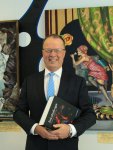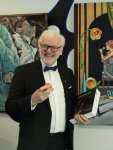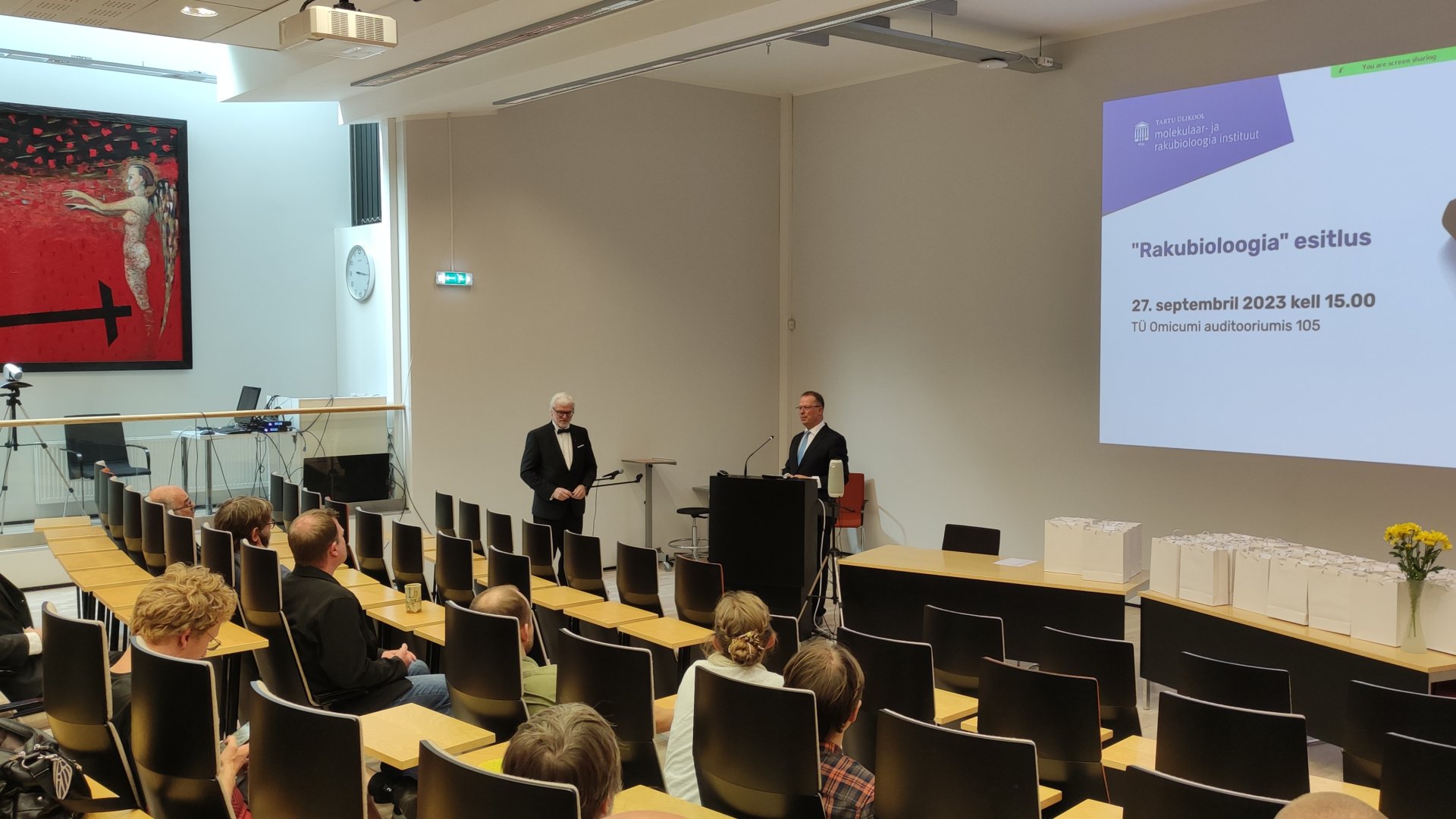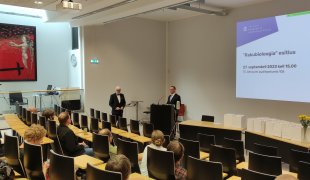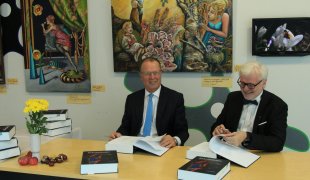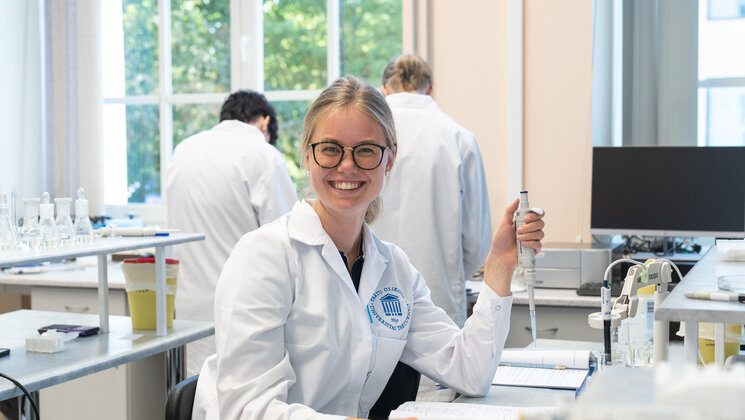An exceptionally comprehensive Estonian-language university textbook on cell biology has been published
On 27 September, the presentation of the new university textbook took place at the University of Tartu Institute of Molecular and Cell Biology. The book entitled Cell Biology, authored by 31 contributors and 2 compilers, guides the reader through the history and established knowledge of cell biology in 17 chapters, as well as presents recent and new directions and trends in this rapidly evolving field of modern science.
Acknowledgements:
The intention to publish such a book dates back more than 30 years. In 1990, the Institute of Molecular and Cell Biology was established at the University of Tartu and soon after that, the Chair of Cell Biology. At that time and still, internationally well-known textbooks in English were used in the teaching process. Despite this, our scientists wanted to prepare a textbook in Estonian. It was also found that the cell biology textbook should include instruction on topics such as tissues and cover related fields (e.g., plant cell biology, developmental biology). The earliest textbook on cell biology in Estonian, Molecular Cell Biology by Professor Toivo Maimets, was published in 1999. The first comprehensive textbook that covered cell biology and its related disciplines was released as an e-textbook in 2018. The fresh textbook Cell Biology has been extensively revised, updated, and expanded. Essentially, it is a completely new textbook.
One of the compilers and authors of the book, Professor Toivo Maimets, takes the discussion about the importance of the textbook all the way back to Enlightenment-era philosophers. He mentions Immanuel Kant's student, the German-born writer and philosopher Johann Gottfried von Herder, who, among other things, included Estonian folk songs in his works and stated that language is the instrument of thought, and thinking depends on language. The Estonian-language university textbook is invaluable to current and future generations.
Although today we tend to primarily discuss sustainable development in terms of the economy and the living environment, it also extends to national culture and science. The new textbook serves as an excellent example of creating and preserving native-language terminology.
Cell Biology in numbers
- Period of the working process: 10 years
- 2 compilers: Sulev Kuuse, Toivo Maimets
- 31 authors
- 17 chapters
- 1,184 pages
- 996 original drawings
- 37 authors of photos
- 214 original photos of Estonian scientists
- 14 authors of drawings
- 4 members of the Pallas University of Applied Sciences who contributed to original drawings
- Altogether 82 people who contributed to the work belonging to 3 generations of Estonian scientists
- Weight: 3.38 kg
- 2 reviewers: Urmas Arumäe, Evelin Loit
- 2 content editors: Rein Sikut, Mart Viikmaa
- Language editor: Mari Mets
- Layout designer: Kairi Kullasepp
- Published by: University of Tartu Press
The textbook has 31 authors, all of whom are specialists in their respective narrower fields of science in Estonia. The multiplicity of authors enables to provide an overview of cell biology as a highly diverse discipline for college students, graduate students, teachers, professors, as well as dedicated enthusiasts in the field, and why not even for accomplished upper secondary school students who are interested in delving deeper into the subject.
Recognising the power of collaboration, the book's cover features the motto 'Nemo solus satis sapit,' a quote from the ancient Roman playwright Titus Maccius Plautus, which translates to 'No one knows enough alone.' Therefore, in addition to scientists covering various biology disciplines, the book's authors also include doctors, chemists, and physicists.
The richness of the Estonian language and the vitality of its people are not found in easily understandable simplifications, but in the wealth of all our dialects, regional variations, and various professional languages. The professional language of cell biology is a testament to this.
According to Sulev Kuuse, the head of the vivarium at the University of Tartu, and one of the authors and compilers of the textbook, a total of 82 individuals were involved in the preparation of the book, when counting not only the authors but also the artists and illustrators. This new university textbook will be used not only at the University of Tartu but also at the Estonian University of Life Sciences, Tallinn University of Technology, and various Estonian medical schools.
The book introduces readers to the history and established knowledge of cell biology in 17 chapters, as well as new directions and trends in this rapidly evolving field. The textbook is illustrated with numerous explanatory diagrams, tables and photos including 996 drawings. Out of nearly 500 photos in the book, 214 are original photos from Estonian scientists. The textbook includes chapters on developmental biology, immunology, stem cells, cell differentiation and tumour formation, as well as histology, which complement the general understanding of cell biology. The textbook is equipped with a terminology and author index. A recommended reading chapter is also included, which aligns with the teaching of cell biology at the University of Tartu.
Tiina Alamäe
Andres Arend
Joachim Matthias Gerhold
Ain Heinaru
Sulev Ingerpuu
Lilian Kadaja-Saarepuu
Kalle Kisand
Hannes Kollist
Arnold Kristjuhan
Sulev Kuuse
Mardo Kõivomägi
Kristiina Laanemets
Darja Lavõgina
Mart Loog
Dmitri Lubenets
Toivo Maimets
Olga Mazina-Kukk
Aavo-Valdur Mikelsaar
Kärt Padari
Evi Padu
Heiti Paves
Pärt Peterson
Jaanus Remme
Ago Rinken
Osamu Shimmi
Rein Sikut
Artjom Stepanjuk
Pille Säälik
Tanel Tenson
Tambet Tõnissoo
Raivo Uibo
Introduction
The World of Cells
Cell Structure Elements
Cell Connections and Cell Matrix
Cell Communication
Cell Cycle
Meiosis
Developmental Biology
Cell Differentiation
Stem Cells
Cell Programmed Death e.g. Apoptosis
Cancer Biology
Immunity
Mammals Tissue Types
Plant Cell
Model Organisms, Mutations, and Genetically Modified Organisms
Methods of Cell Biology
The publication of the textbook was supported by:
Estonian Ministry of Education and Research, Higher Education Textbook Program
University of Tartu
Faculty of Science and Technology at the University of Tartu
Institute of Molecular and Cell Biology at the University of Tartu
Institute of Genomics at the University of Tartu
Icosagen AS
Solis BioDyne OÜ
Quantum Eesti AS
University of Tartu Press
Media coverage in Estonian:
- Newspaper "Postimees" science column 28.09.2023: Eestikeelne rakubioloogia õpik pakatab uusimaist teadmisist, author Marek Strandberg
- Radio interview in the program: "Behind the Six Pillars". The author of the show is Madis Ligi
- Radio interview on the program: "Falling Apple". The author of the show is Marek Strandberg
- October 2023 issue of "Horisont" magazine
- Newspaper "Tartu Postimees" 06.10.2023: Väikseim elus asi on rakk. Kuidas tekkis? Ei tea! author Aime Jõgi
Media Gallery from September 27, 2023:

